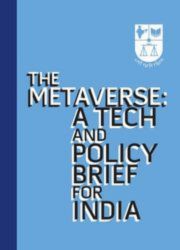
Title: The Metaverse: A Tech and Policy Brief For India
Published on: March 8, 2023
Abstract: It was the cult classic TV show Star Trek that first helped the public imagine a “communicator” that could fit in one’s pocket. This later inspired the design of the flip phone and the wireless bluetooth speaker. History has demonstrated that science fiction and real life eventually collide. The metaverse is a testament to this. The earliest references to it are found in science fiction, with popular media like film and video-games contributing significantly to its conception and popularity.
A simple explanation would describe the metaverse as a shared and immersive virtual reality. It is imagined as a space where physical identities and interactions can be experienced digitally in 3D. However, more technical and exhaustive definitions often describe the metaverse as a composite of its core technologies, by the various uses it has been put to, as well as its potential. Its growth is expected to be both rapid and exponential across industries. The number of users of Web 3.0 virtual worlds today stands at 50,000 and by 2026, it is estimated that 25 percent of the global population will spend one hour a day in the metaverse for digital activities such as work, shopping, social interaction and education.
BUSINESSES HAVE ALREADY BEGUN RESPONDING TO THE ESTIMATED TRILLION DOLLAR POTENTIAL OF THE METAVERSE.
Though tech giants like Meta (formerly Facebook), Microsoft, and Amazon are investing heavily in the space, non-tech firms are also re-orienting their business models to accommodate their own version of the metaverse. Indian businesses are no exception, with MakeMyTrip, Tanishq, Mahindra and Mahindra using metaverse-related tools and
NFTs to expand their business and marketing operations. Social and entertainment use cases, such as metaverse concerts and weddings, are also attracting great attention. Governance applications of the metaverse are also actively being explored through the setting up of virtual embassies, simulating voting, and investing in virtual local
administration platforms.
The metaverse’s rapid development cannot be divorced from its social, legal, policy, and even personal, implications. The metaverse raises unique concerns about the ethical implications of the lines separating virtual reality and real life being blurred. Furthermore, realising the metaverse is an exercise of collaboration between not just complex
technologies, but between corporations, businesses, individuals, and regulatory entities. These concerns are relevant to policy practitioners and users alike. This primer attempts to contextualize the metaverse and its developments to India.
– It will provide a brief overview of its evolution, core principles, and key components.
– Then, it will explore the various use cases of the metaverse across industries and identify major players in the space.
– Lastly, it will articulate the notable regulatory concerns and policy questions facing regulators in India with the development of the metaverse.
This is the second policy brief in the series on Web3 and allied technologies in India. The first policy brief on Web3 can be accessed here.

